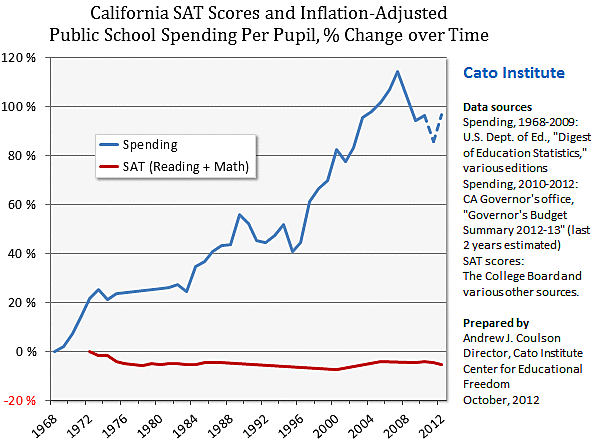Californians are being asked to raise their taxes by between $7 billion (Prop 30) and $10 billion (Prop 38) to prop-up public school budgets. If they don’t, backers warn, public schools will face “devastating cuts.” That’s the fear mongering. This is the reality:
Over the past four decades, real per pupil spending in California has roughly doubled. In dollar terms, Californians are spending $27 billion more today on K‑12 education than they did in 1974, when Gov. Jerry Brown was first elected to office—and that is after controlling for both enrollment growth and inflation.
The last dashed spike on the spending line is the increase if Prop 30 passes, as Governor Jerry Brown has been assuming. If it doesn’t pass, per pupil spending will still be up more than 80 percent over this period, after controlling for inflation. What’s more, there is no evidence that the fantastic spending increases of the past have done anything to improve student achievement.
The only state-level achievement data we have that go back this far are the SATs, and, taking into account the renorming that occurred in the mid 1990s, they have actually declined by five percent. None of the customary excuses can explain away this dismal record. A larger share of students participated in 1972 than do so today, so if a shrinking test-taking pool is the sign of a more elite subset of students taking the test, then scores should be higher today, not lower. And while state-level breakdowns by race and ethnicity are not available that far back, the national trend is similar and it shows stagnation in the scores of majority white students—which excludes changing demographics as an explanation.
As I wrote earlier this year:
It is true that a $7 billion tax increase would at least preserve a certain number of public sector jobs, even if those jobs have not, and likely will not, improve educational outcomes. But if that $7 billion is not taxed out of the free-enterprise sector of California’s economy, it will preserve or create private-sector jobs when it is spent or invested. And, contrary to the pattern shown in the accompanying chart, jobs in the free-enterprise sector do produce things that people value: from movies and music to citrus fruits and cellphones—thus generating new revenue. Tax away that money and you take away those private-sector jobs and revenue.
The final question boils down to this: Can Californians afford to tax $7 billion out of the productive sector of the economy and get nothing in return for the damage it would do?
That’s the question California voters must ask themselves on November 6th.

